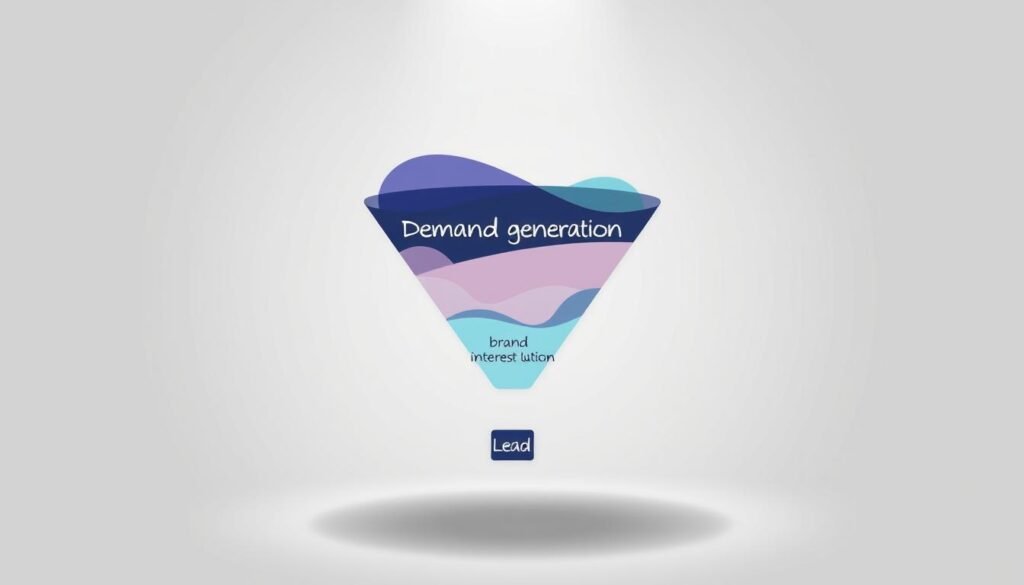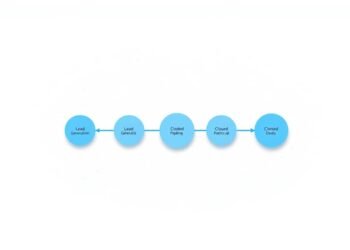Have you ever wondered why some marketing efforts attract crowds while others focus on converting ready-to-buy prospects? Many businesses struggle to distinguish between two critical strategies: demand generation and lead generation. Though they work together, their goals and methods differ.
Demand gen creates awareness and interest in your brand. It educates potential customers before they even consider buying. On the other hand, lead gen captures contact details from those already showing intent. Modern B2B buyers research extensively before engaging with sales, making both approaches essential.
This article breaks down their differences, explores when to use each, and shows how they complement one another. You’ll also learn key metrics and real-world success stories, like Cognism’s 4x inbound pipeline growth.
Key Takeaways
- Demand generation builds brand awareness early in the buyer’s journey.
- Lead generation focuses on capturing interested prospects.
- Both strategies are crucial for a complete marketing funnel.
- Modern buyers research independently, requiring tailored approaches.
- Success depends on aligning tactics with buyer intent.
Introduction to Demand Generation and Lead Generation
Modern buyers no longer wait for sales pitches—they actively seek information before making decisions. According to Salesforce, 81% of buyers research brands independently before contacting sales teams. This shift demands strategies that meet buyers at every stage of their journey.
Demand generation focuses on the 99% of potential customers not yet ready to buy, as Cognism’s CMO notes. It builds brand awareness through content, social media, and thought leadership. Think of a sneaker brand partnering with athletes—it creates desire long before a purchase.
In contrast, lead generation targets those showing intent. A retailer’s limited-time discount converts interested shoppers. This tactic thrives in the middle and bottom of the marketing funnel, capturing contact details for sales teams.
Both strategies are vital. Demand gen plants seeds; lead gen harvests them. The key is aligning efforts to guide buyers seamlessly from curiosity to conversion.
What Is Demand Generation?
Building brand loyalty begins long before a prospect is ready to purchase. Unlike tactics that chase immediate sales, demand generation nurtures relationships with potential customers early in their journey. It’s about creating value and trust, so when buyers are ready, your brand stands out.
Definition and Core Objectives
Alice de Courcy, Cognism’s CMO, describes it as “friction-free, always-on” content for the 99% of buyers not actively shopping. The goal? Educate and engage, turning unknown audiences into future advocates. Key objectives include:
- Increasing brand search volume and website traffic.
- Fostering engagement through problem-solving resources.
- Building authority in your industry.
Key Tactics in Demand Generation
Effective strategies focus on visibility and value. For example:
- Ungated blogs and podcasts: Teach solutions without asking for contact details.
- LinkedIn social selling: Share insights to spark conversations.
- Dark social distribution: Leverage private channels like Slack communities.
Cognism’s shift to ungated content and LinkedIn engagement boosted inbound leads by 4x. This shows the power of prioritizing audience needs over short-term conversions.
What Is Lead Generation?
Not all marketing efforts aim to educate—some exist purely to capture ready-to-buy prospects. While demand generation builds awareness, lead generation focuses on converting interest into actionable entries in your CRM. It targets the 1% of buyers actively researching solutions, as noted in Cognism’s framework.
Definition and Core Objectives
At its core, lead generation is about capturing contact information from potential customers showing intent. Tools like gated eBooks or webinar sign-ups turn anonymous visitors into leads. The goal? Move prospects through the sales funnel efficiently.
For example, a whitepaper download might trigger an email sequence nurturing the lead toward a product demo. Unlike broad awareness campaigns, this strategy prioritizes quality over quantity.
Key Tactics in Lead Generation
Effective tactics include:
- Gated content: Trade valuable resources (e.g., templates) for contact details.
- Demo requests: Let prospects experience your solution firsthand.
- Lead scoring: Systems like Lucidspark’s rank prospects by engagement level.
Avoid outdated methods that generate “zombie leads”—contacts who never convert. Instead, focus on high-intent signals like repeated website visits or form submissions.
Demand Generation vs Lead Generation: Key Differences
The buyer’s journey isn’t linear—strategies must adapt to different stages of interest. While both approaches aim to grow your business, they serve distinct roles in the sales funnel. Here’s how they differ in focus and execution.
Funnel Stages and Focus Areas
Demand generation targets the top of the funnel, creating awareness among cold audiences. Think blog posts or LinkedIn discussions—content that educates without asking for contact details. Cognism’s data shows these efforts yield a 0.2% close rate but lay groundwork for future conversions.
In contrast, lead generation operates in the middle and bottom funnel. It captures ready-to-act prospects through gated content or demo requests. Cognism’s inbound inquiries boast a 20% close rate, proving intent matters.
Transactional vs. Relationship-Building
Lead gen thrives on immediacy. An eBook download or webinar sign-up is transactional—valuable for quick wins but limited in long-term impact. As Fran Langham notes, moving beyond an “MQL-driven mindset” to storytelling campaigns builds deeper trust.
Demand gen, however, invests in relationships. Poor execution here leads to low-quality SQLs—like fishing in empty waters. Time horizons differ too: demand gen spans months or years, while lead gen focuses on weeks or months.
Together, they create a seamless path from curiosity to purchase. Align each tactic with buyer intent, and your funnel will thrive.
Goals of Demand Generation
Silent research drives 62% of B2B decisions—demand generation meets buyers there. Unlike tactics chasing quick wins, it builds brand awareness and trust long before purchases happen. Here’s what success looks like:
Audience expansion: Reach new segments through ungated content like blogs or podcasts. Proofpoint’s pivot to educational webinars doubled their inbound inquiries.
Authority building: Position your brand as a thought leader. Lucidspark’s template tracks metrics like organic search growth and backlinks—signs of rising influence.
Lead gen priming: Cognism’s $13M inbound pipeline started with ungated guides. These resources nurtured prospects until they were ready to engage.
Customer re-engagement: Keep existing buyers invested with newsletters or community forums. Dark social channels (Slack, WhatsApp) amplify this quietly.
Avoid vanity metrics—10K LinkedIn likes mean little if pipeline impact is zero. Focus on strategies that drive measurable growth, not just noise.
Goals of Lead Generation
Turning interested visitors into paying customers requires a strategic approach to capturing intent. Unlike broad awareness campaigns, lead generation focuses on converting engaged prospects into actionable sales opportunities. Its goals span database growth, trust-building, and deeper customer insights.
Quality trumps quantity. Cognism’s inbound leads boast a 20% close rate because they prioritize sales-qualified (SQL) criteria. Tools like lead scoring help identify readiness—tracking behaviors like repeated website visits or demo requests.
Cross-promotion amplifies results. Partnering with complementary brands expands reach while maintaining relevance. Salesforce, for example, drives website traffic through Instagram story conversions, turning social engagement into contact information.
Challenges exist. High customer acquisition costs (CAC) from unqualified leads strain resources. Alignment between marketing and sales teams is critical—shared definitions of “qualified” prevent friction.
Actionable tip: AI tools like Sales Cloud analyze lead behavior patterns, helping teams focus on high-potential opportunities. This ensures lead generation efforts drive measurable revenue, not just numbers.
Metrics to Measure Success
Data-driven decisions separate effective campaigns from wasted budgets in digital marketing. While both demand generation and lead generation fuel growth, their success requires distinct measurement approaches. Tracking the right metrics reveals what’s working—and where resources should shift.
Demand Generation Metrics
Top-funnel efforts focus on visibility and engagement. Cognism’s 4x pipeline growth stemmed from monitoring:
- Organic search growth: Rising branded queries indicate increasing awareness
- Dark social shares: Private messages (Slack/WhatsApp) signal genuine interest
- Time-on-page: 3+ minutes suggests content resonates with audiences
Brand lift surveys help attribute offline impact, while Google Analytics 4 tracks multi-touch journeys.
Lead Generation Metrics
Middle-funnel tactics prioritize conversion rates and efficiency. Top performers like Salesforce track:
- Cost per lead (CPL): Elite teams maintain
- Demo request rates: 15%+ conversion indicates strong offer-market fit
- Email CTRs: 5-10% shows messaging effectiveness
CRM dashboards reveal sales-cycle impacts—Cognism reduced theirs by 22% through lead scoring.
Avoid misattribution by separating top-funnel influence from last-click conversions. HubSpot’s attribution reports help distinguish how awareness campaigns eventually drive pipeline—even months later.
When to Prioritize Demand Generation
Timing determines whether your marketing fuels long-term growth or quick wins. Demand generation excels in scenarios where building awareness outweighs immediate conversions. Here’s when to focus on it:
New market entry: Entering an untapped vertical? Follow Salesforce’s playbook—combine targeted email campaigns with display ads to educate your target audience first. EVBox’s journey template maps awareness phases for structured outreach.
Post-merger rebranding: Mergers dilute brand recognition. Lucidspark’s trade-show follow-up template reignites interest through ungated webinars and SEO-optimized guides.
Seasonal pushes: Holidays or industry events prime audiences for education. Allocate 70%+ of budgets to demand generation during these peaks if you’re an early-stage company.
Product launches: Before pitching features, create curiosity. A pre-launch blog series or podcast can mirror Cognism’s 4x pipeline growth strategy.
Competitive gaps: Losing to rivals? Counter with thought leadership—not promotions. Dark social shares and organic search growth rebuild credibility.
Caution: Avoid demand gen during short-term revenue crunches. It’s a marathon, not a sprint. Redirect efforts to lead gen when time or cash flow is tight.
When to Prioritize Lead Generation
Effective marketing knows when to shift from awareness to action. While nurturing audiences is vital, certain scenarios demand a laser focus on lead generation. This strategy excels when you need to convert ready-to-buy prospects quickly.
End-of-quarter pushes often require immediate pipeline boosts. Targeted retargeting sequences or limited-time offers can spur action. For example, a SaaS company might gate a premium webinar to capture contact details before a fiscal deadline.
ABM campaigns thrive on high-intent signals. Cognism’s shift to paid search for bottom-funnel terms like “product demo” increased qualified leads by 30%. Tailor landing pages to specific account needs for better conversions.
Optimize lead magnets carefully. Free tool access often outperforms eBooks—it provides instant value. Track ROI using: (Revenue per lead × conversion rate) – CAC. Avoid over-gating; balance with ungated top-funnel content to maintain trust.
Caution: Prioritize lead generation only when urgency aligns with buyer readiness. Misaligned timing wastes sales resources on cold prospects.
How Demand and Lead Generation Work Together
Top performers don’t choose between strategies—they integrate them seamlessly. Demand generation and lead generation form a powerful flywheel: one builds awareness, while the other captures intent. Together, they fuel sustainable growth.
Complementary Roles in the Funnel
Think of the funnel as a loop, not a straight line. Ungated content educates cold audiences, while gated offers convert warm prospects. Cognism’s $13M inbound pipeline started with LinkedIn thought leadership (demand) and scaled with targeted demo ads (lead).
Recycling matters too. Cold leads nurtured with blogs or webinars often re-enter the funnel. Shared KPIs between teams ensure alignment—like tracking how top-funnel content influences later conversions.
Case Study: Balancing Both Strategies
Cognism’s campaign shows the synergy. Their ungated guides attracted 50K+ monthly visitors. Retargeting engaged readers with demo offers boosted conversions by 30%. Tools like Lucidspark mapped this journey visually, aligning marketing and sales.
Actionable tip: Use CRM platforms like Salesforce to track touchpoints. A lead might discover your brand through a podcast (demand), then sign up for a trial (lead) months later. Connecting these dots reveals the full impact of your marketing strategy.
Common Pitfalls to Avoid
Even the best strategies can fail if common mistakes aren’t avoided. Cognism’s initial 0.2% close rate on content leads proves how small errors create big impacts.
Over-gating content tops the list. Requiring contact details too early scares off 68% of visitors (Salesforce data). Balance free resources with lead capture.
Ignoring the dark funnel is equally damaging. LinkedIn engagement drives 40% of Cognism’s pipeline—yet many undervalue it in attribution models.
Team silos create friction. Marketing and sales misalignment costs companies 10%+ in lost revenue annually. Shared KPIs fix this.
Fran Langham’s “who over how many” philosophy applies here. Quality leads matter more than quantity—especially when time and resources are limited.
Post-sale neglect hurts retention. Continuing brand education after purchase turns customers into advocates. This fuels referrals and repeat business.
Actionable checklist:
- Audit existing assets for over-gating
- Track dark funnel touchpoints
- Align teams on lead qualification process
- Invest in multi-touch attribution tools
Tools and Resources for Execution
Executing effective campaigns requires more than ideas—it demands the right technology. The right stack turns strategies into measurable results, whether nurturing awareness or capturing ready-to-buy prospects.
CRM Platforms: Salesforce Sales Cloud centralizes lead tracking and automates follow-ups. HubSpot’s free tier suits startups, while advanced features scale with growth.
Content Collaboration: Lucidspark’s templates align teams visually. Use them to map buyer journeys or brainstorm campaigns.
Free Resources: Cognism’s ungated demand generation course teaches audience-building. Google’s Market Finder reveals geographic insights for expansion.
AI Enhancements: Predictive scoring prioritizes high-intent leads. Chatbots handle 24/7 queries, nurturing interest until sales teams engage.
Cost Comparisons: HubSpot ($$) offers all-in-one solutions. Mailchimp ($) excels for email campaigns but lacks CRM depth.
Integration Roadmap: Start with Google Analytics 4 for baseline metrics. Add automation tools, then layer AI for scalability. This phased approach prevents overwhelm.
Conclusion
Successful marketing blends awareness and conversion. Demand and lead gen aren’t rivals—they’re partners. Cognism’s 4x pipeline growth and 20% close rates prove their power when combined.
Today’s buyers value trust over transactions. Brands that educate first and sell second win long-term loyalty. Use the tools and strategies shared here to refine your approach.
Audit your current mix. Are you balancing top-funnel content with targeted offers? Adjust based on buyer intent and funnel stage.
As Cognism’s CMO says: “In B2B marketing, whoever builds trust and captures attention wins.” Start optimizing now.
FAQ
What’s the main difference between demand generation and lead generation?
Demand generation focuses on creating brand awareness and interest in your product, while lead generation captures contact information from potential customers ready to engage further.
How does demand generation help in marketing?
It builds long-term relationships with your audience through content, social media, and campaigns, increasing overall brand recognition and trust.
What are common lead generation tactics?
Tactics include email marketing, gated content, webinars, and landing pages designed to collect prospect details for sales follow-up.
When should I prioritize demand gen over lead gen?
Prioritize demand gen when launching a new product or entering a new market to educate and engage potential buyers first.
Which metrics matter most for lead generation success?
Track conversion rates, cost per lead, and lead quality to measure how effectively your strategies turn prospects into qualified leads.
Can demand and lead generation work together?
Yes! Demand gen nurtures top-of-funnel interest, while lead gen converts engaged audiences into actionable sales opportunities.
What’s a common mistake in demand generation?
Focusing only on short-term campaigns instead of building lasting audience engagement through consistent, valuable content.
What tools support lead generation efforts?
CRMs like HubSpot, email platforms like Mailchimp, and analytics tools like Google Analytics help streamline and track lead gen performance.










